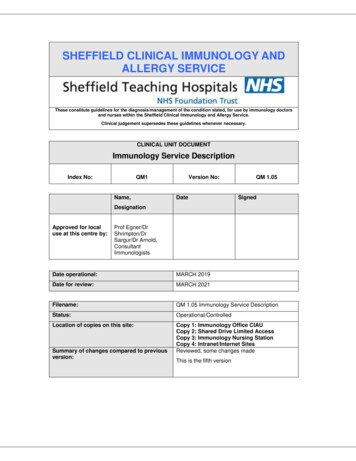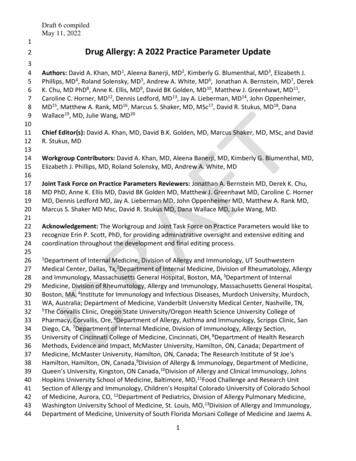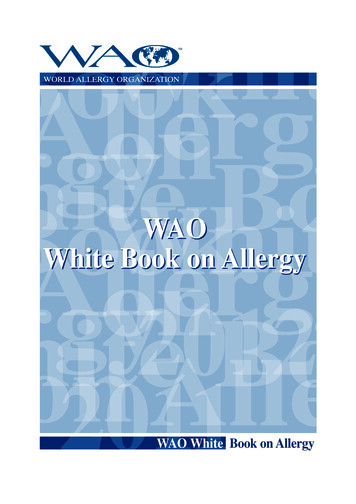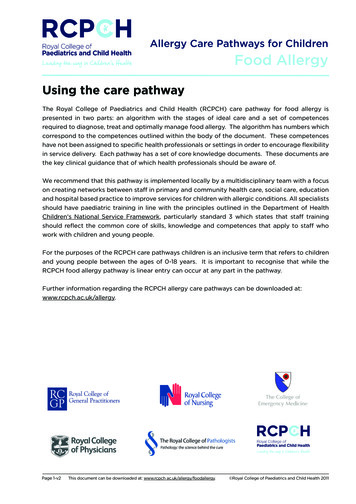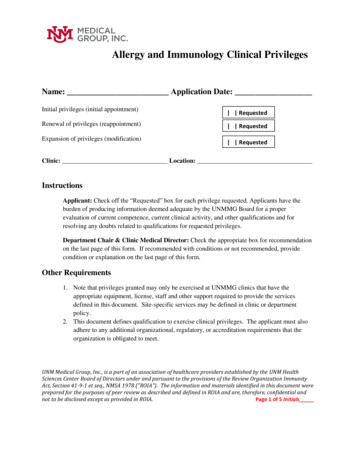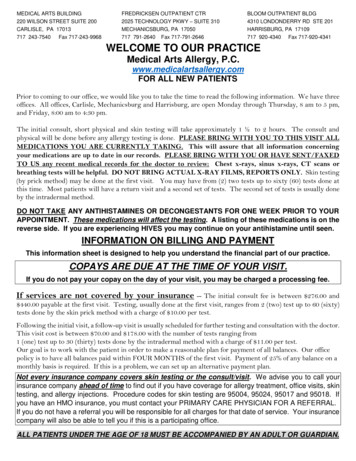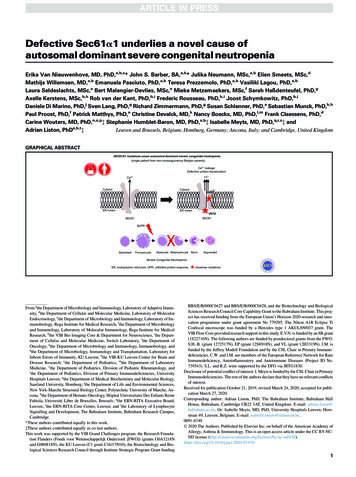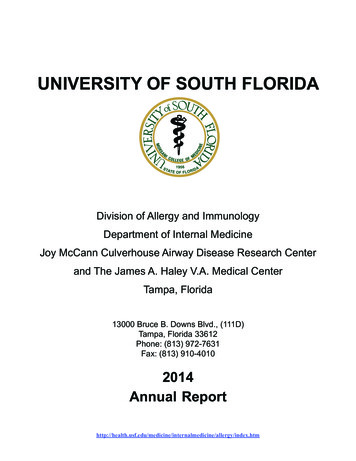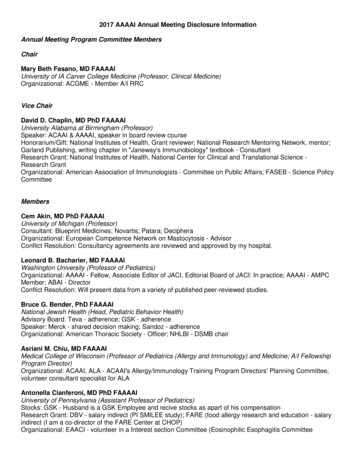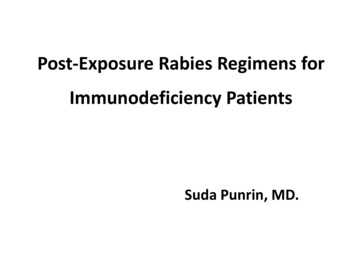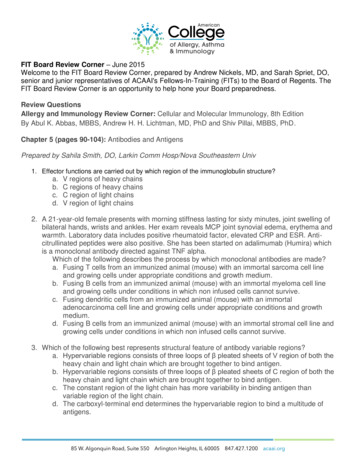
Transcription
FIT Board Review Corner – June 2015Welcome to the FIT Board Review Corner, prepared by Andrew Nickels, MD, and Sarah Spriet, DO,senior and junior representatives of ACAAI's Fellows-In-Training (FITs) to the Board of Regents. TheFIT Board Review Corner is an opportunity to help hone your Board preparedness.Review QuestionsAllergy and Immunology Review Corner: Cellular and Molecular Immunology, 8th EditionBy Abul K. Abbas, MBBS, Andrew H. H. Lichtman, MD, PhD and Shiv Pillai, MBBS, PhD.Chapter 5 (pages 90-104): Antibodies and AntigensPrepared by Sahila Smith, DO, Larkin Comm Hosp/Nova Southeastern Univ1. Effector functions are carried out by which region of the immunoglobulin structure?a.b.c.d.V regions of heavy chainsC regions of heavy chainsC region of light chainsV region of light chains2. A 21-year-old female presents with morning stiffness lasting for sixty minutes, joint swelling ofbilateral hands, wrists and ankles. Her exam reveals MCP joint synovial edema, erythema andwarmth. Laboratory data includes positive rheumatoid factor, elevated CRP and ESR. Anticitrullinated peptides were also positive. She has been started on adalimumab (Humira) whichis a monoclonal antibody directed against TNF alpha.Which of the following describes the process by which monoclonal antibodies are made?a. Fusing T cells from an immunized animal (mouse) with an immortal sarcoma cell lineand growing cells under appropriate conditions and growth medium.b. Fusing B cells from an immunized animal (mouse) with an immortal myeloma cell lineand growing cells under conditions in which non infused cells cannot survive.c. Fusing dendritic cells from an immunized animal (mouse) with an immortaladenocarcinoma cell line and growing cells under appropriate conditions and growthmedium.d. Fusing B cells from an immunized animal (mouse) with an immortal stromal cell line andgrowing cells under conditions in which non infused cells cannot survive.3. Which of the following best represents structural feature of antibody variable regions?a. Hypervariable regions consists of three loops of β pleated sheets of V region of both theheavy chain and light chain which are brought together to bind antigen.b. Hypervariable regions consists of three loops of β pleated sheets of C region of both theheavy chain and light chain which are brought together to bind antigen.c. The constant region of the light chain has more variability in binding antigen thanvariable region of the light chain.d. The carboxyl-terminal end determines the hypervariable region to bind a multitude ofantigens.
Page 2 of 74. The ability for antibodies to distinguish between small differences in chemical structure is alsoknown as:a. Affinity maturationb. Diversityc. Specificityd. Repertoire5. A protein antigenic determinant that then becomes phosphorylated is called a:a. Conformational determinantb. Linear determinantc. Neoantigenic determinantd. Epitope6. The strength of the binding between a single combining site of the antibody and an epitope ofan antigen is called:a. Affinity Maturationb. Affinityc. Diversityd. Avidity7. A 23-year-old female presents with abdominal pain and diarrhea which is foul smelling. Shereports eating raw meat. A complete blood count reveals eosinophilia. Which of the followingcan explain the increase in eosinophils?a. Naïve IgD and IgM B cells recognize parasite antigen and thus switch to IgE isotypeto carry out the process of antigen elimination.b. B cells switching to the IgG isotype also prolongs the effectiveness of humoralresponses.c. IgM B cells recognize linear determinants of parasites and IgM progeny rid the body ofparasites.8. A 35-year-old male presents to your office with fever, chills, headache and photophobia. Onexam he has positive Kerning’s sign. Cerebral spinal fluid from lumbar puncture reveals gram‘spositive diplococci. Broad spectrum antibiotics are started. Patient’s symptoms improve afterthree days. Which of the following describes how effector functions are initiated?a. Ig molecules without antigen can trigger effector functions.b. Antibodies bound with antigen care able to trigger effector functions via a process calleddiversity.c. Antibodies with bound antigens activate effector mechanisms with two or more adjacentantibody Fc portions which are needed to bind and trigger complement pathway.9. The hinge region of antibodies allows for flexibility in the molecule. A single antibody matattach to a single multivalent antigen by more than one binding site. Which of the followingdescribes avidity as is relates to antibody binding antigen?a. Monovalent epitopes spaced apart has low avidity interactionb. Bivalent epitopes bound by one molecule of IgG has high avidity and high affinity.c. If the affinity is low then the avidity must also be low.d. IgM molecules have ten identical sites to bind polyvalently to multiple epitopes at onceleading to very high avidity.
Page 3 of 710. An immunology student is running an experiment with rabbit IgG in the laboratory. The studentadds pepsin to one dish and finds the Ig molecules breaks into distinct pieces. She then addspapain into another dish and a similar reaction occurs. Which of the following accuratelydemonstrates the immunology student’s observations?a. Papain cleaves rabbit IgG into three distinct pieces; two identical VL and CL called Fab(fragment, antigen binding). The third piece is CH2 and CH3 domains which iscrystalized and called (fragment, crystalizable). Pepsin results in proteolysis distal tohinge region equaling both VL and CL. Hinge and disulfide bonds are intact and thismolecule is also known as F(ab’)2. The remaining C region is broken down into variouspeptides.b. Pepsin cleaves rabbit IgG into three distinct pieces; two identical V L and CL called Fab(fragment, antigen binding).The third piece is CH2 and CH3 domains which is crystalizedand called (fragment, crystalizable). Papain results in proteolysis distal to hinge regionequaling both VL and CL. Hinge and disulfide bonds are intact and this molecule is alsoknown as F(ab’)2. The remaining C region is broken down into various peptides.c. Papain cleaves rabbit IgG into two distinct pieces; one V L fragment called Fab(fragment, antigen binding). The second piece is two identical CH2 and CH3 domainswhich is crystalized and called (fragment, crystalizable). Pepsin results in proteolysis ofthe Ig molecule leaving various peptide fragments.d. Papain does not cause any proteolysis and thus results in intact Rabbit IgG. Pepsinresults in proteolysis distal to hinge region equaling both VL and CL. Hinge and disulfidebonds are intact and this molecule is also known as F(ab’)2. The remaining C region isbroken down into various peptides.Answers1. B, page 90.Effector functions are mediated through C regions of heavy chains, but these functions are triggeredby binding of antigens to the combining site in the V region.2. B, page 95.Georges Kohler and Cesar Milstein in 1975 infused an animal (mouse) with an immortal myeloma cellline and grew cells under conditions in which non infused cells cannot survive. The resultant fusedcells are called hybridomas.3. A, pages 90-91.Hypervariable regions consists of three loops of β pleated sheets of V region of both the heavy chainand light chain which are brought together to bind antigen.4. C, pages 102-103Experiments performed in the 20th century demonstrated that antibodies made in response to anamino-benzene hapten with a meta-substituted sulfonate. Groups would bind strongly bind to thishapten but weakly or not at all to ortho- or para-submitted isomers. These antigens are structurallysimilar and differ only in the location of the sulfonate group on the benzene ring.5. C, pages 100-101.
Page 4 of 7Proteins may be subjected to modifications such as glycosylation, phosphorylation, ubiquitination,acetylation, and proteolysis. These modifications, by altering the structure of the protein, can producenew epitopes. They too can be recognized by specific antibodies.6. B, page 101.The affinity is commonly represented by a dissociation constant (Kd), which indicates a stronger orhigher affinity interaction because a lower concentration of antigen and of antibody is required forcomplex formation.7. A, page 104.After stimulation by an antigen, a single clone of B cells may produce antibodies with differentisotypes that nevertheless possess identical V domains and therefore identical antigen specificity.Naïve B cells simultaneously express IgM and IgD that function as membrane receptors for antigens.When these B cells are activated by foreign antigens, typically of microbial origin, they may undergo aprocess called isotype switching8. C, page 104.The reason that only antibodies with bound antigens activate effector mechanism is that two or moreadjacent antibody Fc portions are needed to bind to and trigger various effector systems, such ascomplement proteins and FcRs of phagocytes.9. D, pages 101-102.The hinge region of antibodies allows for flexibility in the molecule. A single antibody mat attach to asingle multivalent antigen by more than one binding site. IgM molecules have ten identical sites tobind polyvalently to multiple epitopes at once leading to very high avidity.10. A, pages 90-91, figure 5-3 A.Papain cleaves rabbit IgG into three distinct pieces; two identical VL and CL called Fab (fragment,antigen binding). The third piece is CH2 and CH3 domains which is crystalized and called (fragment,crystalizable). Pepsin results in proteolysis distal to hinge region equaling both VL and CL. Hinge anddisulfide bonds are intact and this molecule is also known as F(ab’)2. The remaining C region isbroken down into various peptides.Review QuestionsAllergy and Immunology Review Corner: Cellular and Molecular Immunology, 8th EditionBy Abul K. Abbas, MBBS, Andrew H. H. Lichtman, MD, PhD and Shiv Pillai, MBBS, PhD.Chapter 5 (pages 97-105): Antibodies and AntigensPrepared by Priscilla Wong, MD, Wilford Hall Ambulatory Surgical CenterAll/Immun 59 MDOS/SG05A1. Which antibody isotype has the shortest half-life in circulation?a. IgAb. IgGc. IgEd. IgM
Page 5 of 72. Which antibody is a pentamer?a. IgAb. IgGc. IgEd. IgM3. Therapeutic agents such as abatacept (CTLA4-Ig) and etanercept (TNFR-Ig) are fusionproteins where the biologically active parts of the target proteins are fused to the Fc region ofhuman IgG. To what receptor does IgG bind enabling its long half-life?a. FcγRIb. FcRnc. FcαRId. FcγRIII4. A mature, naive B cell expresses which of the following?a. IgGb. Membrane IgMc. Membrane IgM and IgDd. Cytoplasmic μ heavy chain and pre-B cell receptor5. In the tissues of patients with an immune complex disease like systemic lupus erythematosus,which of the following is present when polyvalent antigens are mixed with antibody in a testtube during a clinical flare?a. Zone of antigen excessb. Zone of equivalencec. Zone of antibody excessd. Zone of neutrality6. The affinity of the antibody and the avidity contribute to the strength of antigen-antibodyinteractions. Which of the following antigen-antibody combinations represents the strongestinteraction?a. Monovalent antigen – IgEb. Monovalent antigen – IgMc. Polyvalent antigen – IgGd. Polyvalent antigen – IgM7. In affinity maturation, the average binding affinity of an antibody for antigen changes in whichprogression?a. Kd 10-1 to Kd 101b. Kd 10-9 to Kd 10-11c. Kd 101 to Kd 103d. Kd 104 to Kd 106
Page 6 of 78. The effector functions of immunoglobulins are mediated by which portion of the molecule?a. Antigen binding siteb. Fabc. Fc regiond. V region9. Which antibody is efficiently secreted through mucosal epithelia and is the major class ofantibody in mucosal secretions and human milk?a. IgAb. IgEc. IgMd. IgG10. During affinity maturation, which of the following occurs?a. Somatic mutations in the CH regionb. Germline mutations in the V regionc. Germline mutations in the V regiond. Somatic mutations in the V regionAnswers1. C, page 99.IgE has a very short half-life of 2 days in the circulation, circulating IgA has a half-life of about 3 days,and circulating IgM has a half-life of about 4 days. In contrast, circulating IgG molecules have a halflife of about 21-28 days.2. D, pages 101.For pentameric IgM, a single antibody may bind at up to 10 different sites” whereas “IgG or IgE caninvolve at most 2 binding sites.”3. B, page 99.“The long half-life of IgG has been used to provide a therapeutic advantage for certain injectedproteins by producing fusion proteins containing the biologically active part of the protein and the Fcportion of the IgG. The Fc portion enables the proteins to bind to the FcRn and thus extends the halflives of the injected proteins. One therapeutically useful fusion protein is TNFR-Ig” ”Anothertherapeutically useful fusion protein is CTLA4-Ig.”4. C, pages 97.Mature B cells express membrane forms of IgM and IgD. These membrane Ig receptors serve as cellsurface receptors that recognize antigens and initiate the process of B cell activation.5. B, page 102, Figure 5-14.“If a polyvalent antigen is mixed with a specific antibody in a test tube, the two interact to formimmune complexes. At the correct concentration, called a zone of equivalence, antibody and antigenform an extensively cross-linked network of attached molecules such that most or all of the antigenand antibody molecules are complexed into large masses.” ”If a zone of equivalence is reached in
Page 7 of 7vivo, large immune complexes can form in circulation. Immune complexes that are trapped or formedin tissues can initiate an inflammatory reaction, resulting in immune complex diseases.”6. D, page 101.“Polyvalent antigens will have more than one copy of a particular determinant. Although the affinity ofany one antigen-binding site will be the same for each epitope of a polyvalent antigen, the strength ofthe attachment is called the avidity and is much greater than the affinity of any one antigen-bindingsite. Thus, a low-affinity IgM molecule can still bind tightly to a polyvalent antigen because many lowaffinity interactions (up to 10 per IgM molecule) can product a high avidity interaction.”7. B, page 103.“The affinity is commonly represented as a dissociation constant (Kd) which indicates how easy it isto separate an antigen-antibody complex into its constituents. A smaller Kd indicates a stronger orhigher affinity interaction because a lower concentration of antigen and antibody is required forcomplex formation. The Kd of antibodies produced in typical humoral immune responses usuallyvaries from Kd 10-7 to Kd 10-9 M .”Affinity maturation results in an increase in the average bindingaffinity of antibodies for antigen as a humoral immune response evolves. Thus, an antibody producedduring a primary immune response to a protein antigen often has a Kd in the range of K d 10-9 to Kd10-11M; in secondary responses, the affinity increases, with a Kd of 10-11”8. C, page 103.“Many of the effector functions of immunoglobulins are mediated by the Fc portions of the molecules,and antibody isotypes that differ in these Fc regions perform distinct functions.”9. A, page 105.“IgA can be secreted efficiently across mucosal epithelia and is the major class of antibody inmucosal secretions and milk.”10. D, page 103, Figure 5-15.“A mechanism for the generation of high-affinity antibodies involves subtle changes in the structure ofthe V regions of antibodies during T cell-dependent humoral immune responses to protein antigens.These changes come about by a process of somatic mutation in antigen-stimulated B lymphocytesthat generates new V domain structures, some of which bind the antigen with greater affinity than didthe original V domains (Fig 5-15)”
FIT Board Review Corner - June 2015 Welcome to the FIT Board Review Corner, prepared by Andrew Nickels, MD, and Sarah Spriet, DO, senior and junior representatives of ACAAI's Fellows-In-Training (FITs) to the Board of Regents. The FIT Board Review Corner is an opportunity to help hone your Board preparedness. Review Questions
